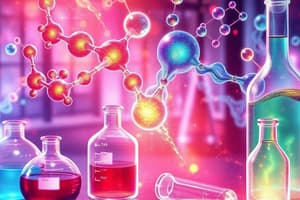Podcast
Questions and Answers
What is the product formed when Ca(OH)2 reacts with SO2?
What is the product formed when Ca(OH)2 reacts with SO2?
- CaSO4
- Ca(HSO3)2
- CaSO3 (correct)
- H2O2
Which of the following reactions can bleach the brown color of iodine?
Which of the following reactions can bleach the brown color of iodine?
- SO2 + H2O
- SO2 + H2O + I2 (correct)
- Cl2 + I2
- H2S + I2
What color change occurs when K2Cr2O7 reacts with SO2?
What color change occurs when K2Cr2O7 reacts with SO2?
- Green to orange
- Red to blue
- Orange to green (correct)
- Blue to yellow
Which of the following salts is insoluble in water?
Which of the following salts is insoluble in water?
What happens to persulfates when boiled with water?
What happens to persulfates when boiled with water?
Which of the following substances will form a white precipitate when reacted with BaCl2?
Which of the following substances will form a white precipitate when reacted with BaCl2?
What will happen to the precipitate of BaSO3 when it is boiled?
What will happen to the precipitate of BaSO3 when it is boiled?
Which anion will result in the decolorization of iodine solution without forming a precipitate?
Which anion will result in the decolorization of iodine solution without forming a precipitate?
When reacting with iodine, which anion will produce sulfur as a precipitate?
When reacting with iodine, which anion will produce sulfur as a precipitate?
Which ions are slightly soluble in the context of thiosulfate salts?
Which ions are slightly soluble in the context of thiosulfate salts?
Flashcards
SO2 reducing properties
SO2 reducing properties
SO2 can reduce the color of acidified KMnO4, iodine, and acidified K2Cr2O7.
Thiosulfate (S2O32-) reaction with HCl
Thiosulfate (S2O32-) reaction with HCl
Thiosulfate initially shows no reaction with cold HCl, but upon warming or standing, it becomes a turbid (cloudy) solution due to colloidal sulfur and SO2 gas formation.
Sulfate (SO42-) reaction with HCl
Sulfate (SO42-) reaction with HCl
Sulfates show no reaction with dilute HCl.
Persulfate (S2O82-) reaction with water
Persulfate (S2O82-) reaction with water
Signup and view all the flashcards
Solubility of sulfides
Solubility of sulfides
Signup and view all the flashcards
Thiosulfate solubility
Thiosulfate solubility
Signup and view all the flashcards
Sulfate solubility
Sulfate solubility
Signup and view all the flashcards
Persulfate solubility
Persulfate solubility
Signup and view all the flashcards
Sulfide, sulfite, and thiosulfate reducing action
Sulfide, sulfite, and thiosulfate reducing action
Signup and view all the flashcards
Study Notes
Anions Part 1
- This lecture covers carbonate/bicarbonates and sulfur-containing anions.
- Salts are ionic compounds formed from the assembly of anions and cations.
- Anions are negative ion fragments in a salt, contributed by acids.
- Cations are positive ion fragments in a salt, contributed by bases.
Anions Qualitative Analysis
- Anion identification relies on dry and wet reactions, along with specific and selective reactions for each anion.
- Dry reactions involve treating solid salts with acids to identify volatile products, such as carbon dioxide (effervescence).
- Wet reactions involve reacting salt solutions with reagents, resulting in color changes, precipitation, or oxidation-reduction reactions.
Carbonates and Bicarbonates
- Carbonates and bicarbonates are salts of carbonic acid.
- Carbonate is CO32-.
- Bicarbonate is HCO3-.
- All carbonate salts are insoluble except alkali (Na, K, Li) and ammonium carbonate.
- Alkali (Na, K, Li), Ammonium, and alkali earth (Mg, Ba, Ca, Sr) bicarbonates are soluble in water.
- Dry reaction with dilute HCl causes effervescence, creating CO2 gas in carbonates and bicarbonates.
- Wet reaction with BaCl2 solution produces a precipitate.
Sulfur-Containing Anions
- Sulfide (S2-)
- Sulfite (SO32-)
- Thiosulfate (S2O32-)
- Sulfate (SO42-)
- Persulfate (S2O82-)
Dry Reactions - Addition of Dilute HCl
- Sulfides: H2S evolves on heating.
- Detection: rotten egg odor, darkening of lead acetate paper, or cadmium acetate paper.
- Sulfites: SO2 evolves; detected by burnt sulfur odor, and turbidity in limewater.
- Thiosulfates: No immediate change on cold; turbid solution on warming because of H2S2O3 decomposition.
- Sulfates: No reaction with dilute HCl.
- Persulfates: No reaction on cold, decomposes to form oxygen (O) on boiling.
Wet Reactions - Reaction with BaCl2
- Sulfides: No reaction.
- Sulfites: White precipitate (BaSO3) which in soluble in dilute HCl
- Thiosulfates: No precipitate on cold; precipitate (BaS2O3) upon boiling.
- Sulfates: White precipitate (BaSO4) that is insoluble in dilute HCl.
- Persulfates: White precipitate (BaSO4) on boiling.
Wet Reactions - Reducing Action, with Iodine (I2) and KMnO4 solution
- Sulfides, sulfites, and thiosulfates act as reducing agents in reactions with iodine and permanganate
- The results include: decolorization, turbidity and different color changes
Special Tests and Spot Tests
- Sulfides: Cadmium carbonate reacts with sulfides to form CdS; canary yellow precipitate.
- Thiosulfates: A blood-red color of ferric thiocyanate complex is created by heating with KCN solution, NaOH, acidification and FeCl3 addition.
- Sulfates: Sulfate is reduced to sulfide by heating a mixture of sulfate, Sodium Carbonate and charcoal in a reducing flame. brownish black stain forms on a silver coin when tested.
Analysis Of Mixtures
- Procedures for identifying mixtures containing various sulfur-containing anions.
- Separation methods and identifying techniques for individual anions are detailed.
Additional Information
- Contact information for the lecturer
Studying That Suits You
Use AI to generate personalized quizzes and flashcards to suit your learning preferences.




